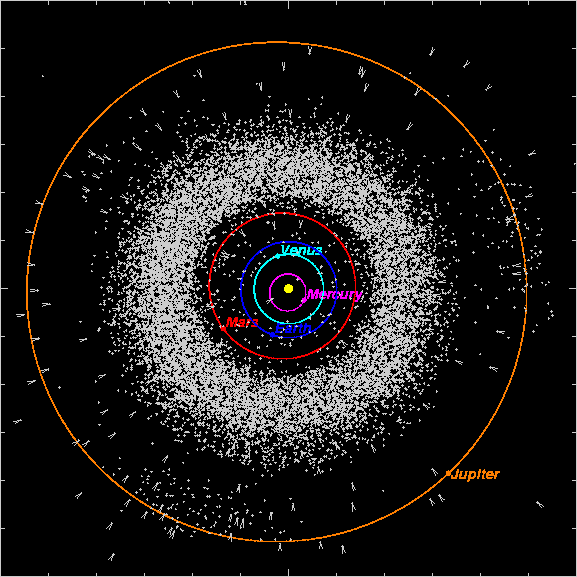Space EnvironmentWhat is in space? |
Almost all of the asteroids in our solar system are orbiting in a broad band 19,400,000 miles wide between Jupiter and Mars. The asteroids are orbiting the Sun, each one traveling around the Sun fast enough for the orbits not to degrade. If something slows an asteroid, it may "fall" towards the Sun, towards Mars, or towards Jupiter. As both Jupiter and Mars move past the asteroids in their orbits, they may be pulled slightly towards those huge bodies in their orbits. In fact, Phobos and Diemos, the two tiny moons of Mars, may be captured asteroids.

Image from the Solar System Dynamics Group of the Jet Propulsion Laboratory,
Solar System Orbits Diagrams and Distribution Graphs Web Page, http://ssd.jpl.nasa.gov/orbit_diagrams.html.
Some scientists believe that the asteroid belt was made when a planet that was there exploded or collided with something else and broke up. Other scientists believe that the material making the asteroids never came together into a planet at all.
The chart below shows how asteroids compare to each other in terms of how far they are from the Sun (semi major axis) and what the shape of their orbit is. Just like many other bodies in the solar system, the orbits made by asteroids are not perfect circles, but ellipses. The axis marked eccentricity is a measure of how far from circular each orbit is. The smaller the eccentricity number is, the more circular the orbit is.

Image from the Solar System Dynamics Group of the Jet Propulsion Laboratory,
Solar System Orbits Diagrams and Distribution Graphs Web Page, http://ssd.jpl.nasa.gov/orbit_diagrams.html.
![]()
What is an asteroid, a planetoid, a meteoroid a micrometeoroid?
What is in space besides planets and stars?
What is an orbit?
What causes an orbit to happen?
What travels in an orbit?
![]()
How is an ellipse different from a circle?
What is the orbital plane?
Are there orbits within orbits?
![]()
How do we know what's in space?
What are the orbital lengths and distances of objects in our solar system?
![]()